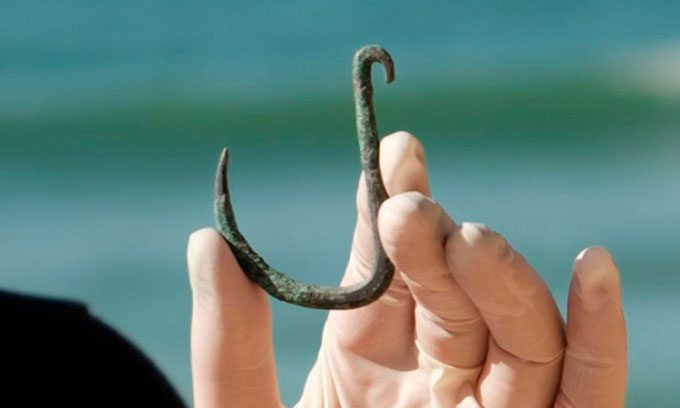The Israel Antiquities Authority has announced the discovery of one of the oldest metal fish hooks at the Chalcolithic village in the city of Ashkelon.
In a press release last week, the Israel Antiquities Authority (IAA) stated that the hook is made of copper and is remarkably well-preserved, dating back approximately 6,000 years. It measures 6.5 cm in length and 4 cm in width.

The giant fish hook excavated in Chalcolithic, Ashkelon, Israel. (Photo: IAA).
“It is characteristic in size and shape of hooks used for shark or tuna fishing, but in the coastal region of Israel and the eastern Mediterranean, tuna are not as common as they are in the southern Mediterranean,” said Dr. Yael Abadi-Reiss from the IAA in an interview with the Times of Israel.
Researchers believe that this hook is sturdy enough to catch fish measuring between 2 to 3 meters in length. This size corresponds well with two species of sharks found in the area: the dusky shark (Carcharhinus obscurus) and the sandbar shark (Carcharhinus plumbeus).
Located about 4 km from the coast, the remaining ruins of the Chalcolithic village indicate that it was a very resource-rich agricultural community where inhabitants cultivated wheat, barley, legumes, fruit trees, and raised livestock. They lived there for at least 600 years in houses concentrated around three large stone structures, possibly religious buildings. A few hundred meters from the village is a metallurgical area where the copper hook may have been produced.

Ruins of buildings from the Chalcolithic village excavated in Ashkelon. (Photo: IAA)
According to the IAA, this new discovery provides evidence that the local people ventured out to sea and deployed the newly crafted giant hooks to supplement their diet with shark meat.
Previous archaeological evidence along the Israeli coast has also shown that sharks were caught for their meat, skin, and other valuable products. Numerous depictions of sharks appear in various artistic works and artifacts, such as pottery and mosaics, indicating their significance in the cultural and artistic heritage of ancient coastal communities.
In another case, archaeologists discovered shark teeth in a burial site dating back to the 5th century BC in Ashkelon, where the remains of a young woman were adorned with a necklace made of shark teeth.
On April 3, the Israel Antiquities Authority showcased the shark hook at the 48th Archaeological Congress held at the Givat Ram campus of the Hebrew University in Jerusalem. This annual conference is jointly organized by the IAA, the Israel Exploration Society, and the Israel Archaeological Society.


















































